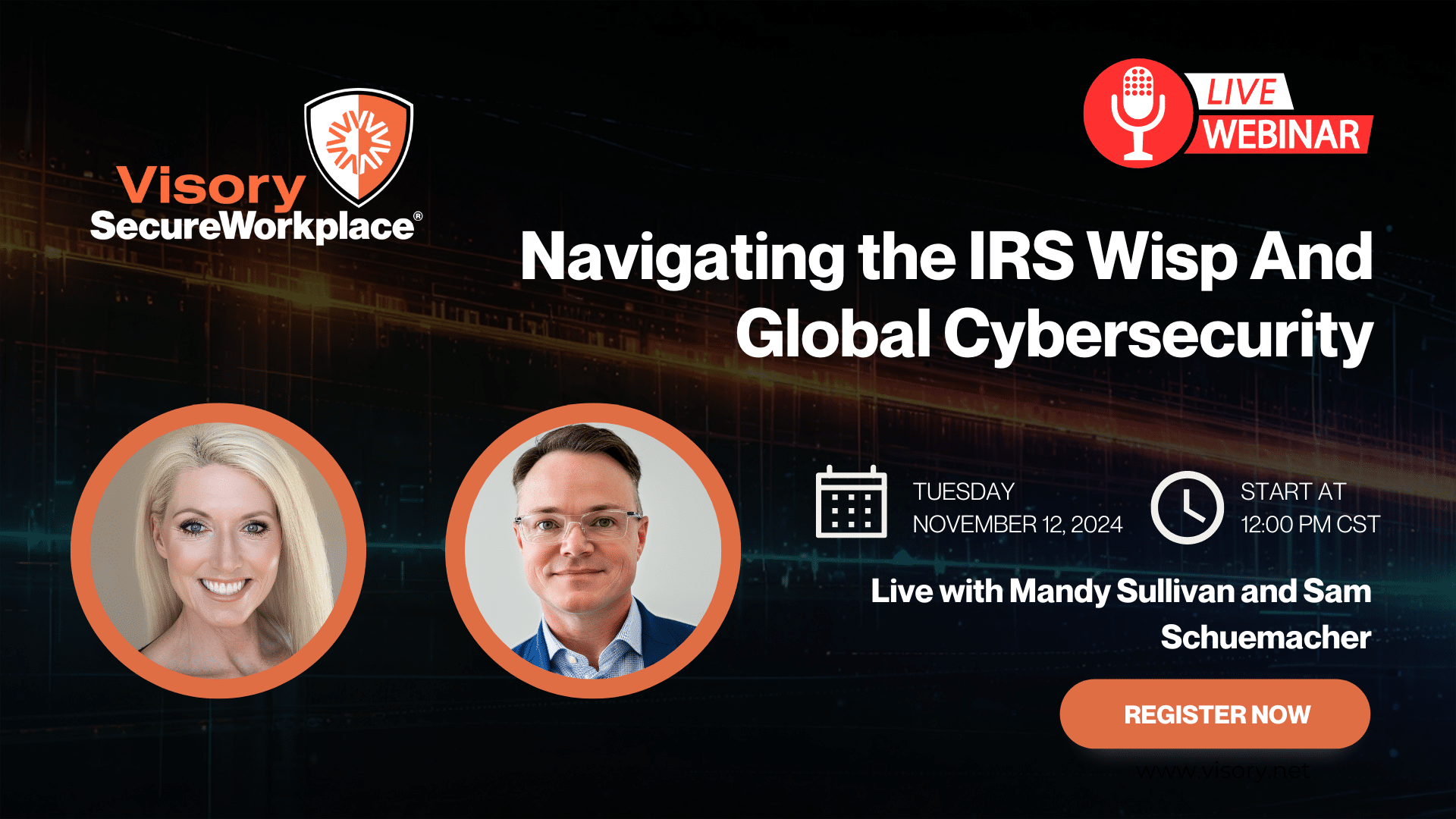The hallmark of the Visory experience, our dedicated team of professionals provides a high degree of support for all your IT needs
Leading edge solutions that are always working to maintain the integrity of your firm’s IT backbone
Best in class security to protect your firm’s data and technology
Tips, advice, and industry insight from our team of accountants and business owners to yours.
Bypass the wait time and access Visory’s Obsessive Client Support®
Take your business to new heights with Visory’s flexible QuickBooks hosting solutions
The same Sage you work in every day, only better
An affordable CRM for small- and medium-sized businesses, built to support your sales, marketing and customer service needs
Revolutionize your next tax season with added efficiency and mobility
Access critical applications that are integrated seamlessly into your workflow, conveniently hosted on the same server
Access affordable enterprise-grade hosting solutions with none of the IT burden

We’ll help you develop and implement the right cybersecurity policies and protocols to keep your firm secure and in compliance with regulatory guidance
We’re here to manage your firm’s IT activity, safeguarding the integrity of your infrastructure and devices, so you don’t have to
Our dedicated professionals can be your outsourced IT team, so your internal resources don’t have to bear the burden of uptime alone.
We’ll manage your cybersecurity policies and protocols to keep your firm secure and in compliance
Security that ensures everyone granted access is who they claim to be
Educate and train your most important last line of defense – your people
Protection where people and their machines intersect
Secure access to your data. Reduce the risk of compromise, prevent cyberthreats.
A different approach to protecting emails
Secure single sign-on access for a connected world
Backup your data for business continuity and compliance
Keep everyone on the same page. Any user, every device.
Secure connections for all your users, devices and networks
Get started on a robust security plan with a WISP for your business
Protect your organization with the expertise of our Chief Information Security Officers (CISO) without having to hire a full-time resource

IRS 4557 and the FTC Safeguards Rule
Complying with state and federal privacy regulations and more
Get started on a robust security plan with a WISP for your business
Educate and train your most important last line of defense — your people.
Protect your organization with the expertise of our Chief Information Security Officers (CISO) without having to hire a full-time resource
Lorem ipsum dolor sit amet, consetetur sadipscing elitr, sed diam nonumy
Lorem ipsum dolor sit amet, consetetur sadipscing elitr, sed diam nonumy
Lorem ipsum dolor sit amet, consetetur sadipscing elitr, sed diam nonumy
Lorem ipsum dolor sit amet, consetetur sadipscing elitr, sed diam nonumy
Lorem ipsum dolor sit amet, consetetur sadipscing elitr, sed diam nonumy
In 2022, 20% of cyber breaches were ransomware attacks, with only 13% of organizations that suffered from a ransomware attack not paying the ransom. Ransomware is a type of malware that blocks users from accessing data and files by encrypting them. The attacker then demands a ransom from the victim to restore access. Unlike other cyberattack methods, ransomware holds information hostage, crippling business operations until a ransom is paid or other recovery methods are used.
Ransomware attacks can harm your business more than just financially; They can lead to delays, loss of trust, legal issues, and harm your company’s reputation in the future. By taking precautions and understanding ransomware, you can protect your company and react swiftly if attacked.
How Do Ransomware Attacks Work?
Ransomware often infiltrates a computer system and encrypts the user’s files with strong cryptographic algorithms. Once the attacker gains access to your system, they will demand a ransom in cryptocurrency. Attackers demand this ransom in exchange for the decryption key needed to unlock your data.
The process operates secretly and quickly; once you find the encryption, it’s likely too late to prevent the damage. Some advanced ransomware variants can also spread across networks, encrypting data on other connected systems to magnify the impact.
Common Types of Ransomware
- Crypto Ransomware: This type of ransomware focuses on encrypting valuable data and files to block users from accessing them. In this scenario, you can only obtain the decryption key by paying the ransom in cryptocurrency. Notorious examples include WannaCry and Petya.
- Locker Ransomware: Unlike crypto ransomware, this variant locks users out of their entire system, not just specific files. Early forms of ransomware like Reveton are prime examples of locker ransomware attacks.
- Double Extortion Ransomware: A more recent and sinister evolution, double extortion ransomware encrypts and exfiltrates data. Attackers demand payment or they will expose private information, like in the Maze ransomware found in May 2019.
- RaaS (Ransomware as a Service): RaaS is when ransomware creators rent out their infrastructure to other cybercriminals. REvil, responsible for 37% of ransomware attacks in 2021, is an example of this business model.
Ransomware Infection Methods
- Phishing Emails: Phishing emails are one of the most common methods of ransomware and trick users into downloading malicious files or clicking links that lead to malware-filled websites. A recent study indicated that 41% of ransomware attacks were achieved through phishing emails.
- Exploiting Network Vulnerabilities: Attackers often exploit unpatched vulnerabilities in software or operating systems to gain unauthorized access and deploy ransomware.
- Drive-By Downloading: This form of infection typically doesn’t require any user interaction and occurs when users visit a hacked website and ransomware is downloaded onto their system.
- Remote Desktop Protocol (RDP) Attacks: Cybercriminals use brute force attacks or stolen credentials to gain access through RDP, a common remote access tool that IT professionals commonly use to troubleshoot an issue.
- Malvertising: Attackers can inject malicious code into online advertising networks to execute ransomware attacks through a user’s browser.
How Can You Prevent Ransomware Attacks?
To safeguard your company from ransomware, you need both advanced technology and human vigilance to work together. To prevent a ransomware attack from negatively impacting your business, use the following techniques:
Complete a Risk Assessment
The first action you should take to prevent ransomware attacks is to conduct a thorough risk assessment. This process involves identifying vulnerabilities within your business’s IT infrastructure that ransomware could exploit. Vulnerabilities in your infrastructure can range from outdated software and unpatched systems to weak passwords and weak network security. Pinpointing weak spots allows you to prioritize areas for immediate improvement and strengthen your overall cybersecurity.
Apart from finding weaknesses, you should evaluate how a ransomware attack could impact your business through data loss, operational downtime, and reputational damage. Understanding the scope of potential damage allows you to effectively allocate resources to data backup solutions, employee training, and robust incident response plans.
Regularly Update Software and Patch Vulnerabilities
The first action you should take to prevent ransomware attacks is to conduct a thorough risk assessment. This process involves identifying vulnerabilities within your business’s IT infrastructure that ransomware could exploit. Vulnerabilities in your infrastructure can range from outdated software and unpatched systems to weak passwords and weak network security. Pinpointing weak spots allows you to prioritize areas for immediate improvement and strengthen your overall cybersecurity.
Apart from finding weaknesses, you should evaluate how a ransomware attack could impact your business through data loss, operational downtime, and reputational damage. Understanding the scope of potential damage allows you to effectively allocate resources to data backup solutions, employee training, and robust incident response plans.
Implement Effective Antivirus and Anti-Malware Solutions
Antivirus and anti-malware are crucial for protecting your systems against ransomware and other harmful software. They detect and stop these threats from entering your systems. Options like Visory’s cybersecurity solution can detect and protect against viruses in real-time.
Educate and Train Employees
Human error is a major vulnerability in cybersecurity, so educating your employees about the risks and common methods of ransomware can significantly reduce the likelihood of successful attacks. To ensure your team is aware of and can manage new security threats, conduct regular training sessions.
Advanced Protection Strategies for Ransomware Attacks
To bolster your defenses against sophisticated attackers, you can adopt advanced protective strategies such as network segmentation. Network segmentation divides the network into secure sections, limiting ransomware spread and controlling user access to sensitive data and systems.
You can use firewalls and intrusion detection systems to monitor and control network traffic. These protections can also stop potential threats before they enter the system. Also make sure you create a strong backup plan to quickly recover your data in the event of a ransomware attack.
What Happens After a Ransomware Attack?
Even with comprehensive preventative measures, you can’t entirely eliminate the possibility of a ransomware attack. That’s why it’s critical to have a well-defined recovery plan in place. After a ransomware attack, restore systems and data from secure off-site backups. These backups allow you to regain access to critical data, reducing downtime and financial losses.
After an attack, analyze what happened, how it happened, and find ways to prevent it from happening again. The process should review how the attack happened, assess the response, and discover which security measures failed. Use gained insights to strengthen your defenses, update policies, and redefine preventative measures for better protection against future attacks.
Safeguard Against Ransomware with Visory
Ransomware attacks are a significant and evolving threat to businesses of all sizes. To prevent ransomware attacks and reduce their impact, it’s crucial to grasp their workings and implement effective prevention and recovery plans.
Visory has extensive experience in navigating and handling cyberattacks of all kinds. We are committed to staying ahead of new threats and provide effective security strategies to strengthen your defenses against ransomware. Additionally, we have a recovery plan in place to minimize damage.
Learn more about our cybersecurity solutions and how we can secure your business against the unpredictable. To start a conversation about your cybersecurity needs, contact a Visory expert today.

You’ve Been Breached — Now What?

Protect Your Firm’s Future: E-Guide on Cybersecurity and Managed IT for RIAs

Year-End Housekeeping for Accountants

Tax Season Readiness: Implementing the Security Six for CPA Firms





